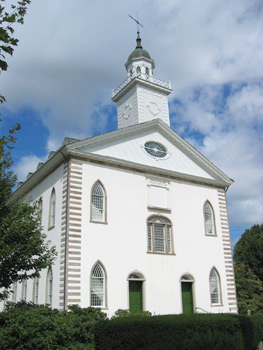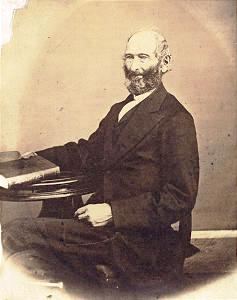Early Mormonism had a range of doctrines related to race with regards to black people of African descent. References to black people, their social condition during the 19th and 20th centuries, and their spiritual place in Western Christianity as well as in Mormon scripture were complicated.

Sidney Rigdon was a leader during the early history of the Latter Day Saint movement.

Times and Seasons was a 19th-century Latter Day Saint newspaper published at Nauvoo, Illinois. It was printed monthly or twice-monthly from November 1839 to February 1846. The motto of the paper was "Truth will prevail," which was printed underneath the title heading. It was the successor to the Elders' Journal and was the last newspaper published by the Church in the United States before the schisms that occurred after the death of Joseph Smith.

The Evening and the Morning Star was an early Latter Day Saint movement newspaper published monthly in Independence, Missouri, from June 1832 to July 1833, and then in Kirtland, Ohio, from December 1833 to September 1834. Reprints of edited versions of the original issues were also published in Kirtland under the title Evening and Morning Star.

The Latter Day Saints' Messenger and Advocate, often shortened to Messenger and Advocate, was an early Latter Day Saint monthly newspaper published in Kirtland, Ohio, from October 1834 to September 1837. It was the successor to The Evening and the Morning Star and the predecessor to the Elders' Journal.

The Latter Day Saint movement is a religious movement within Christianity that arose during the Second Great Awakening in the early 19th century and that led to the set of doctrines, practices, and cultures called Mormonism, and to the existence of numerous Latter Day Saint churches. Its history is characterized by intense controversy and persecution in reaction to some of the movement's doctrines and practices and their relationship to mainstream Christianity. The purpose of this article is to give an overview of the different groups, beliefs, and denominations that began with the influence of Joseph Smith.

David Whitmer was a leader in the Church of Jesus Christ of Latter Day Saints who eventually became the most interviewed of the Three Witnesses to the Book of Mormon's golden plates.

The Kirtland Temple is a temple of the Community of Christ, formerly the Reorganized Church of Jesus Christ of Latter Day Saints, located in Kirtland, Ohio, United States. It is the first temple built by adherents of the Latter Day Saint movement and was designed by Joseph Smith, the founder and original leader of the movement. The design mixes the Federal, Greek Revival, and Gothic Revival architectural styles. It has been a National Historic Landmark since 1969.

John Whitmer was an early leader in the Latter Day Saint movement. He was one of the Eight Witnesses of the Book of Mormon's golden plates. Whitmer was also the first official Church Historian and a member of the presidency of the church in Missouri from 1834 to 1838.
The succession crisis in the Latter Day Saint movement occurred after the murder of Joseph Smith, the movement's founder, on June 27, 1844.
A Rigdonite is a member of the Latter Day Saint movement who accepts Sidney Rigdon as the successor in the church presidency to the movement's founder, Joseph Smith Jr. The early history of the Rigdonite movement is shared with the history of the Latter Day Saint movement, but as of the 1844 succession crisis becomes distinct. Sidney Rigdon and other church leaders, including Brigham Young and James J. Strang, presented themselves as leaders of the movement and established rival church organizations. Rigdon's group was initially headquartered in Pittsburgh, Pennsylvania. It was known at one point as the Church of Jesus Christ of the Children of Zion, and its adherents are referred to as Rigdonites, or sometimes "Pennsylvania Latter Day Saints" or "Pennsylvania Mormons." The only surviving organization that traces its succession back to Rigdon's organizations is The Church of Jesus Christ, founded by a group of Rigdon's followers led by William Bickerton.
A Comprehensive History of The Church of Jesus Christ of Latter-day Saints: Century I is a six-volume history published in 1930 and written by B.H. Roberts, a general authority and Assistant Church Historian of the Church of Jesus Christ of Latter-day Saints. It should not be confused with the seven-volume History of the Church of Jesus Christ of Latter-day Saints, which was also produced by Roberts in the early 20th-century but as an editor and which focused on the history of Joseph Smith.

The Temple Lot, located in Independence, Missouri, is the first site to be dedicated for the construction of a temple in the Latter Day Saint movement. The area was dedicated on August 3, 1831, by the movement's founder, Joseph Smith. It was purchased on December 19, 1831, by Edward Partridge to be the center of the New Jerusalem or "City of Zion" after Smith said he received a revelation stating that it would be the gathering spot of the Latter Day Saints during the last days.

Liahona is an official magazine of the Church of Jesus Christ of Latter-day Saints. It is named after the word liahona from the Book of Mormon. The magazine began publication in 1977.
The Church of Jesus Christ (Bickertonite) is part of the Latter Day Saint movement. When Joseph Smith, the founder of the movement, died there was a dispute regarding who should lead the church as his successor. The Quorum of the Twelve, led by Brigham Young, argued that they should have the right to lead the church while one of the church leaders, Sidney Rigdon, argued that he should act as protector of the church until a permanent leader was chosen. Those who followed Rigdon formed the "Church of Christ" with its center being Pittsburgh, Pennsylvania. After an attempt to start a communitarian society, Church of Christ broke apart by 1847. William Bickerton associated himself for two years with the Church of Jesus Christ of Latter-day Saints and later left them behind refusing to accept some of their beliefs, including polygamy. In the 1850s Bickerton's preaching led to the formation of a new church in Eastern Pennsylvania. Over the following years Bickerton's church faced two schisms related to doctrinal issues. Its current official name, The Church of Jesus Christ, was adopted by 1941.

The Church of Jesus Christ of Latter-day Saints in Missouri refers to the Church of Jesus Christ of Latter-day Saints and its members in Missouri. The official church membership as a percentage of general population was 1.14% in 2014. According to the 2014 Pew Forum on Religion & Public Life survey, roughly 1% of Missourians self-identify themselves most closely with The Church of Jesus Christ of Latter-day Saints. The LDS Church is the 8th largest denomination in Missouri.
The name of the Church of Jesus Christ of Latter-day Saints is derived from an 1838 revelation church founder Joseph Smith said he received. Church leaders have long emphasized the church's full name, and have resisted the application of informal or shortened names, especially those which omit "Jesus Christ". These informal and shortened names include the "Mormon Church", the "LDS Church", and the "Church of the Latter-day Saints".

The following outline is provided as an overview of and topical guide to the life and influence of Joseph Smith:













